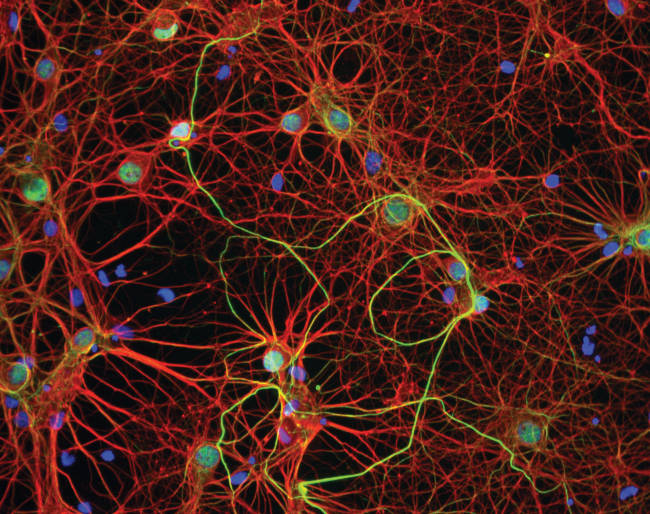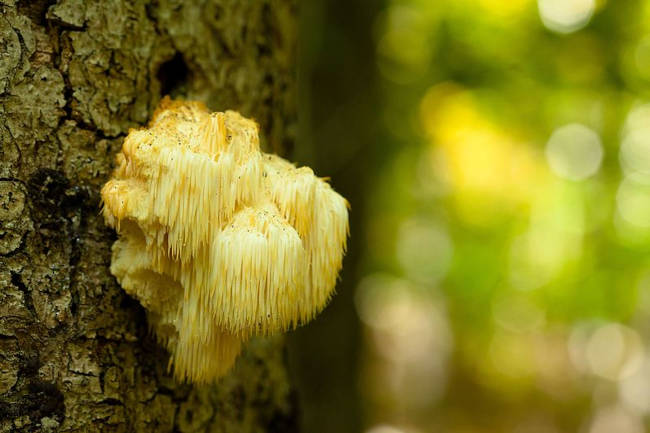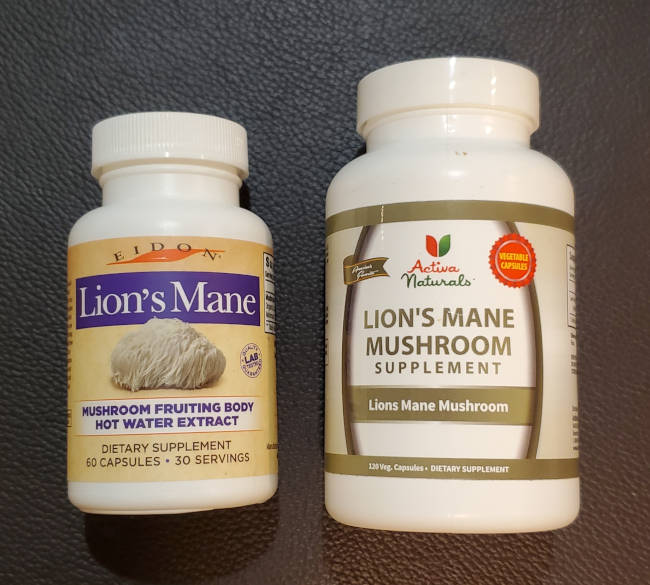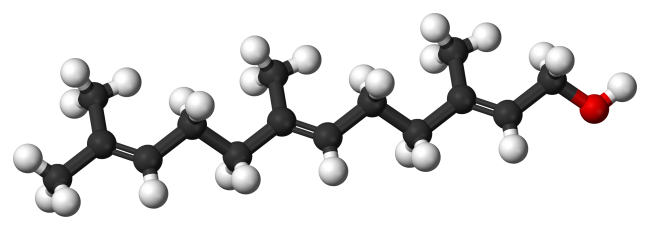Neuroregeneration:
Parkinson’s disease motor symptoms are caused by degeneration of dopamine producing neurons in the Substantia Nigra Pars Compacta located in the brain stem on both the left and right sides of the brain and extend to the Caudate Putamen to provide muscle motor control. Recovery and reversal of Parkinson’s disease symptoms will require the protection, restoration and regeneration of these motor neurons. Although as many as 80% of these neurons become ineffective in a Parkinson's patient, research has shown that 70% are still alive, they just are not functioning. Research is being done on growth factors which stimulate intracellular signaling to promote restoration, growth and synapse formation. Of particular interest are restorative therapies to stimulate regrowth and branching of dopamine axons into the caudate putamen.
One simple and natural method to generate neurotrophic factors and enhance neuroplasticity is to exercise. Experiments delivering Glial Cell Line-derived Neurotrophic Factor (GDNF) directly to the brain required complicated stereotactic surgery because GDNF (and many neurotrophic factors) are unable to cross the blood brain barrier. Neurotrophic factors are also hindered by poor diffusion into tissue and thus the inability to to reach a sufficient number of dopamine neurons to be an effective therapy. Exercise is much safer, simpler and effective promoter of GDNF. See our discussion of physical therapy and exercise to help Parkinson's patients
One effort to develop a GDNF therapy to regenerate neurons is being lead by the National Institute of Neurological Disorders and Stroke (NINDS) and is in a five year phase 1 trail (NCT01621581).
References:
- Neuroregeneration in Parkinson’s Disease: From Proteins to Small Molecules (Sidorova et al, 2019)
"Despite the promising results of in vitro and in vivo experiments, none of the found agents have yet shown conclusive neuro-restorative properties in PD patients. Meanwhile, a few promising biologicals and small molecules have been identified."
"Being relatively large polypeptides, neurotrophic factors are unable to penetrate through the blood-brain barrier and have to be delivered directly into the brain via invasive surgery."
DOI: 10.2174/1570159X16666180905094123

Lion's Mane Mushrooms:
Lion’s mane mushrooms (Hericium erinaceus) have been the subject of research for their apparent ability to help repair nerve damage by inducing the biosynthesis of nerve growth factors (NGF). This is an important distinction to the direct use of NGF which are not able to cross the brain blood barrier due to their physical size. Hericium erinaceus has been used as an herbal medicine in East Asian countries and goes by the name Yamabushitake in Japanese, Houtougu (monkey head) in Chinese, and Lion’s Mane in English. It is believed that its active ingredient is Erinacine A which has antioxidant, anti-aging, antimicrobial, hypolipidemic (cholesterol-lowering), anticancer, immune modulation and neuro-protective properties. The therapeutic potential is being applied to those with peripheral neuropathy, Alzheimer's and Parkinson's. Some results of experiments on mice induced with Parkinson's disease by injecting them with MPTP, showed that treatment with Hericium erinaceus decreased the loss of dopaminergic neurons and a decrease in oxidative stress-induced apoptosis (cell death). Of course animal studies are not conclusive of human efficacy. Lion’s mane mushrooms are available as a dried and ground supplement.
References:- Post-Treatment with Erinacine A, a Derived Diterpenoid of H. erinaceus, Attenuates Neurotoxicity in MPTP Model of Parkinson’s Disease (Kuo et al, 2020)
"In this study, our data indicated that post-treatment with erinacine A prevents MPTP-induced neurotoxicity through increasing the neuronal survival pathways"
"Consistent with our previous studies, pre-treatment or post-treatment with Hericium erinaceus both displayed the antiapoptotic capability of DA neurons in vivo."
DOI: 10.3390/antiox9020137 - Lion's Mane, Hericium erinaceus and Tiger Milk, Lignosus rhinocerotis (Higher Basidiomycetes) Medicinal Mushrooms Stimulate Neurite Outgrowth in Dissociated Cells of Brain, Spinal Cord, and Retina: An In Vitro Study (Samberkar et al, 2015)
"Neurite outgrowth activity was confirmed by the immu-nofluorescence method in all tissue samples."
DOI: 10.1615/intjmedmushrooms.v17.i11.40 - Chemical constituents from Hericium erinaceus and their ability to stimulate NGF-mediated neurite outgrowth on PC12 cells (Zang et al, 2015)
"In conclusion, one new compound (11), along with 10 known compounds (1–10) was isolated from the fruiting bodies of H. erinaceum, and their structures were elucidated by spectroscopic analyses. The chiral HPLC was used to separate the ()- and (+)-antipodes of the two enantiomers, 10 and 11. Compounds (±)-10, ()-10 and (+)-10 exhibited high neurite outgrowth-pro- moting activity in NGF-induced PC12 cells, while this activity of compounds 1, 2 and 3 was weak. These data suggested that the aromatic compounds are further neuroactive substances found in H. erinaceum."
DOI: 10.1016/j.bmcl.2015.10.016

Lion’s mane mushrooms are an edible mushroom characterized by its dangling spines.

Lion’s mane mushroom extract and mushroom supplements
Noopept:
Noopept (N-phenylacetyl-L-prolylglycine ethyl ester) is a drug which has been found to have general nootropic (improve cognitive function) and neuro-protective properties and specifically for Parkinson's patients it has been found to have an effect on alpha-synuclein oligomerization and fibrillation, the mechanism of Parkinson's motor neuron degeneration. Noopept is a nootropic peptide that was developed in Russia to treat age-related cognitive decline and prescribed primarily for the treatment of Alzheimer’s disease, dementia, and other age related cognitive decline. Noopept improves memory by increasing Brain Derived Neurotrophic Factors (BDNF) and Nerve Growth Factors (NGF) found to generate fresh neurons as well as preserving damaged neurons in the Hippocampus. Noopept can be taken orally in powder, tablet or liquid form and can pass through the Blood-Brain Barrier (BBB). Typical doses are 10 – 30 mg per day depending on weight.
Dosage per day:- 10 mg: < 140 lbs
- 20 mg: 140 - 200 lbs
- 30 mg: > 200 lbs
(eg 10 mg, 3 times a day for a 200 lbs person).
A similar nootropic and cholinergics drug is Piracetam. Both Noopept and Piracetam are unregulated by the FDA.
References:
- Neuroprotective and nootropic drug noopept rescues α-synuclein amyloid cytotoxicity (Jia et al, 2011)
"The mitigating effect of noopept against amyloid oligomeric cytotoxicity may offer additional benefits to the already well-established therapeutic functions of this new pharmaceutical."
"The drug action is based on its antioxidant and anti-inflammatory effects, its inhibitory activity towards the neurotoxicity of excess of calcium and glutamate, and its ability to improve blood rheology."
"Therefore, noopept clearly shifts the α-Syn self-assembly process towards fibrillization." (Is this really desired or should it be feared!)
"Upon further incubation for up to 7 days, the fibrils grew even longer, exceeding 5 μm and intertwined with each other, forming ca 15-nm-thick bundles ..." (Shouldn't this be alarming!)
"Thus, noopept rescues the cytotoxicity of α-Syn amyloids by inducing the sequestration of the toxic amyloid oligomers into less harmful fibrillar material." (Is this a true statement?)
"Thus, the α-Syn amyloids produced in the presence of noopept display reduced cytotoxicity since noopept rescues from both apoptotic cell death caused by the amyloid oligomers by reducing their quantity in solution, and it also reduces the necrotic cell death caused by short fibrils by promoting fibrillar elongation"
"Since many neurodegenerative conditions are accompanied by amyloid formation and amyloid cytotoxicity, we have shown here for the first time that noopept significantly modulates the amyloid assembly of α-Syn, the amyloidogenic protein involved in PD and other neurodegenerative synucleinopathies."
DOI: 10.1016/j.jmb.2011.09.044
Farnesol:
Farnesol is a natural compound found in berries, fruits and herbs and capable of inhibiting a protein called PARIS which sabotages the neuro-protective properties of another protein, PGC-1 alpha. Without the protection of PGC-1 alpha, dopamine neurons become dysfunctional and die off, leading to the symptoms of Parkinson's disease. Research at Johns Hopkins University has found farnesol to both significantly prevent the loss of dopamine neurons and reverse motor deficits in mice, indicating its promise as a potential treatment for Parkinson's disease. Mice with Parkinson's which were fed the farnesol supplemented diet, had twice as many healthy dopamine neurons and 55% more PGC-1 alpha in their brains than those not fed the supplemented diet.
While farnesol is used as a flavoring and aromatic by the food and tobacco industry, it is not yet available as a supplement or drug. Also, dosages for human use have not yet been determined.
Foods and plants containing farnesol include:- Tumeric
- Thyme
- Peaches
- Lemongrass (herb)
- Citronella (oil)
- Chamomile (herb)
- Balsam (plant resin)
- Tomatoes
References:
- PARIS farnesylation prevents neurodegeneration in models of Parkinson's disease (Jo et al, 2021)
"Thus, farnesol may be beneficial in the treatment of PD by enhancing the farnesylation of PARIS and restoring PGC-1α activity."
DOI: 10.1126/scitranslmed.aax8891 - PARIS (ZNF746) Repression of PGC-1α Contributes to Neurodegeneration in Parkinson’s Disease (Shin et al, 2012)
"our results suggest that parkin inactivation acting through PARIS and downregulation of PGC-1α contributes to the pathogenesis of PD" - Farnesol quells oxidative stress, reactive gliosis and inflammation during acrylamide-induced neurotoxicity: Behavioral and biochemical evidence (Santhanasabapathy et al, 2015)
"Farnesol supplementation (100mg/kgb.wt.) showed a marked improvement in gait performance, neuromuscular function and fine motor coordination ..."
DOI: 10.1016/j.neuroscience.2015.08.067

Ibogaine:
This alkaloid derived from the central African root bark of the Tabernanthe iboga shrub has been found to increase levels of glial cell line-derived neurotrophic factor (GDNF) and thus has the ability to influence neurogenesis giving it potential as a therapy for neurodegenerative diseases such as Parkinson's disease. GDNF can cause sprouting of dopaminergic neuron fibers and clinical improvement in animal models of Parkinson’s disease and typically requires brain surgery to administer the compound. Ibogaine is a stimulator of GDNF expression in the central nervous system, and thus a much less risky and less invasive approach compared to surgery.
Ibogaine is classified as a Schedule I substance, which makes it illegal for use or possession in the USA. It is also banned in Australia and many European countries but is legal in Canada, Mexico and New Zealand.
References:
- Autoregulation of glial cell line-derived neurotrophic factor expression: implications for the long-lasting actions of the anti-addiction drug, Ibogaine (He and Ron, 2006)
"We show that the initial exposure of cells to Ibogaine or GDNF results in an increase in GDNF mRNA, leading to protein expression and to the corresponding activation of the GDNF signaling pathway."
DOI: 10.1096/fj.06-6394fje - Ibogaine Administration Modifies GDNF and BDNF Expression in Brain Regions Involved in Mesocorticolimbic and Nigral Dopaminergic Circuits (Marton et al, 2019)
"This study demonstrates for the first time that ibogaine administration simultaneously alters the expression of GDNF, BDNF, and NGF transcripts in rat brain regions related to the dopamine neurotransmission in a dose- and time-dependent manner"
LINGO-1:
Research on mice has shown that the LINGO-1 protein is found to be elevated in the substantia nigra of Parkinson's patients and that inhibition of LINGO-1 activity was found to be neuro-protective for midbrain dopaminergic (DA) neurons and induced neurite (axon and dendrites) outgrowth. While the research is promising there is no therapy available for human use.
References:
- Inhibition of the leucine-rich repeat protein LINGO-1 enhances survival, structure, and function of dopaminergic neurons in Parkinson's disease models (Isacson et al, 2007)
"These results show that inhibitory agents of LINGO-1 activity can protect DA neurons against degeneration and indicate a role for the leucine-rich repeat protein LINGO-1 and related classes of proteins in the pathophysiological responses of midbrain DA neurons in PD."
"These observations show that DN-LINGO-1 induces neurite outgrowth by inhibition of endogenous LINGO-1 function."
DOI: 10.1073/pnas.0700901104 - Patent AU2006311828B2: Methods for promoting neurite outgrowth and survival of dopaminergic neurons
"invention is related generally to methods of treating various diseases, disorders or injuries associated with dopaminergic neuronal degeneration or death by administration of an Sp35 antagonist."
:
Pros:
- Neuro-regeneration offers hope for a cure for Parkinson's disease.
Cons:
- No working FDA approved pharmacological therapies are yet available.